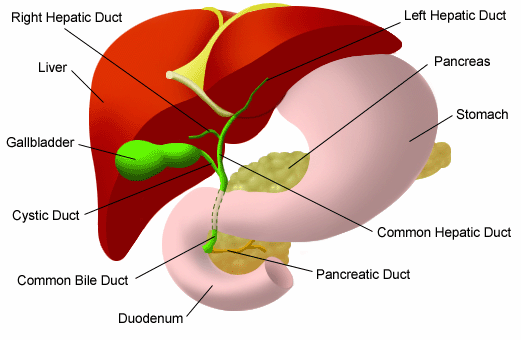The secretion of liver is known as bile. Bile is a clear golden yellow or greenish fluid. It is alkaline in a nature. A normal man secretes about 500 ml to 1 litre in 24 hours. The bile is stored in gall bladder. The capacity of gall bladder is 40-60 ml. Gall bladder is absent in animals such as whale, horses, rats etc.
The bile in the gall bladder is concentrated by the reabsorption of water, bicarbonates, chlorides and sodium. Hence the bile from the liver and that from the gall bladder is slightly different. Bile contains bile salts (sodium and potassium salts of glycochoic and taurocholic acids), bile pigments such as bilirubin (yellow) and biliverdin (green), cholesterol, lecithine, alkaline phosphatase etc.Normal level of bilirubin is 0.2 - 1.2 mg/ 100ml of blood. An increase in level of bile pigment in the blood causes Jaundice. In jaundice no emulsification of fat takes place, so digestion of fat is not completed and the unabsorbed fat appears in the faeces. The bile reaches the duodenum through bile duct. The bile duct is formed by the union of the common hepatic duct and cystic ducts which joins with the pancreatic duct before opening into the duodenum. Most of the functions of bile are due to the presence of bile salts. The following are the major functions of bile salts.
An increase in level of bile pigment in the blood causes Jaundice. In jaundice no emulsification of fat takes place, so digestion of fat is not completed and the unabsorbed fat appears in the faeces. The bile reaches the duodenum through bile duct. The bile duct is formed by the union of the common hepatic duct and cystic ducts which joins with the pancreatic duct before opening into the duodenum. Most of the functions of bile are due to the presence of bile salts. The following are the major functions of bile salts.
 An increase in level of bile pigment in the blood causes Jaundice. In jaundice no emulsification of fat takes place, so digestion of fat is not completed and the unabsorbed fat appears in the faeces. The bile reaches the duodenum through bile duct. The bile duct is formed by the union of the common hepatic duct and cystic ducts which joins with the pancreatic duct before opening into the duodenum. Most of the functions of bile are due to the presence of bile salts. The following are the major functions of bile salts.
An increase in level of bile pigment in the blood causes Jaundice. In jaundice no emulsification of fat takes place, so digestion of fat is not completed and the unabsorbed fat appears in the faeces. The bile reaches the duodenum through bile duct. The bile duct is formed by the union of the common hepatic duct and cystic ducts which joins with the pancreatic duct before opening into the duodenum. Most of the functions of bile are due to the presence of bile salts. The following are the major functions of bile salts.
Functions of Bile
1. They are necessary for the digestion and absorption of fats. They activate pancreatic lipase and help in emulsification of food fats and their absorption in the intestine.2. They keep cholesterol in solution in the bile.
3. They have a mild purgative action.

Thanks for all the information it's awesome
ReplyDelete